What is Online Arbitrage?
Online Arbitrage (OA) involves buying products from online retailers at lower prices and selling them on Amazon for a profit. The process begins with researching and identifying (sourcing) discounted products, followed by a price and competitor analysis to ensure a profitable resale value. After purchasing the items, sellers list them on platforms like Amazon. The profit is calculated by deducting Amazon fees, shipping costs, and the initial product expense.

For example, imagine you discover a popular toy priced at $15 on an online retailer’s website. Recognizing it sells for $25 on Amazon, you purchase 10 units for $150 and list them on Amazon. Once all units are sold, you generate $250 in revenue. After deducting costs, including the initial purchase, Amazon fees, and shipping expenses, you will be left with a profit that you can reinvest in new products, helpful tools, or other resources.
What is Wholesale?
To understand the difference between online arbitrage vs. wholesale, we must also find out what wholesale means. Wholesale on Amazon involves purchasing products in bulk from manufacturers or authorized distributors at discounted rates and reselling them individually on Amazon at a higher price. Profit in this model is derived from the margin between the bulk purchase cost and the retail price on Amazon.

The process begins with supplier outreach, where manufacturers or distributors are identified. Negotiating favorable terms, pricing, and minimum order quantities is crucial to ensure profitability. After placing the bulk order, Amazon listings are created or updated with optimized content. As products sell, inventory monitoring and reordering from the supplier become necessary, and pricing adjustments may be made based on market competition and demand.
For example, imagine you establish a partnership with a toy manufacturer offering a popular toy at a bulk rate of $5 per unit for a minimum order of 100 units. You decide to invest $1,000 in 200 units of this product, listing them on Amazon for $10 each. As all 200 units are sold, you generate a total revenue of $2,000. After accounting for initial purchase costs, Amazon fees, and shipping/storage expenses, you will be left with a profit which you can reinvest in the business. If you want to know how to sell wholesale on amazon, click here.
Online Arbitrage vs. Wholesale
The best way to choose between online arbitrage vs. wholesale is to know their differences and choose accordingly. To help you get to know these business models better, we will compare them from every aspect below:
Business Scale
Online Arbitrage often begins on a smaller scale, based on individual deals, and can be pursued part-time or as a side gig. Its scalability is tied to the time invested in deal hunting. In contrast, Wholesale operations typically require a larger initial investment as they involve bulk purchasing. This model suits consistent, long-term operations and is easier to scale due to reduced reliance on deal hunting.
Products
When comparing online arbitrage vs. wholesale, we find out that OA thrives on diversity, allowing sellers to shift between various products based on deals. This results in a broad range of products over time but with less specialization in any particular category. On the other hand, Wholesale sellers typically concentrate on specific product lines or categories, fostering expertise and specialization in a particular niche.
Suppliers
In OA, products are sourced from diverse online retailers without formal supplier relationships, which can change with each deal. In Wholesale, a formalized, direct relationship is established with manufacturers or authorized distributors, ensuring consistent product supply and the potential for exclusive deals or discounts.
Initial Investment
OA generally demands a lower upfront investment since smaller quantities are purchased based on deals. Wholesale requires a higher initial capital to buy in bulk, but the per-unit cost is often lower, leading to improved profit margins.
Predictability & Consistency
OA is less predictable, relying on finding good deals, resulting in varying sales and profits from month to month. Wholesale, once supplier relationships are established, offers a more predictable flow of products, leading to consistent sales and revenue.
Competition
OA faces higher competition, especially when many sellers spot the same deals, potentially triggering price wars. In Wholesale, competition exists but forging direct relationships with suppliers or securing exclusive deals can provide a competitive advantage.
Pros & Cons of Online Arbitrage and Wholesale
When comparing online arbitrage vs. wholesale, knowing the pros and cons of both business models can be a big help in choosing the right one. Below, we will explain the pros and cons of each business model in detail:
Pros of Online Arbitrage
- Low Initial Investment: Online Arbitrage offers a lower entry barrier compared to wholesale. It allows beginners to start with a modest budget by capitalizing on deals and discounts available in the market.
- Flexibility: OA provides the freedom to pivot without long-term commitments or supplier constraints. Sellers can adapt their product selection based on available deals and shifting market demand.
- Product Diversity: OA enables the sale of a wide range of products spanning different categories. This diversity can act as a buffer against market fluctuations within a specific segment.
- No Need for Supplier Relationships: OA simplifies the sourcing process since it involves purchasing from regular retailers, eliminating the necessity for formal business relationships or negotiations.
- Potential for High Margins: When identifying exceptional deals or discounts, OA presents the opportunity for substantial profit margins when reselling products at their standard prices.
- Low Barrier to Entry: Online Arbitrage offers an exceptionally low barrier to entry into the e-commerce market. It’s accessible to individuals with limited prior experience or resources, making it an attractive option for beginners.
- Low Risk: Compared to other business models like online arbitrage vs. wholesale, OA carries relatively low risk. The ability to source products at discounted prices reduces the financial exposure associated with traditional retail or manufacturing.
- Easy to Restock: When a successful product is identified, it can be repurchased from the same source, streamlining the restocking process.
- High Product Demand: OA often involves selling products with a proven demand in the market. Sellers can tap into existing consumer interest, reducing the uncertainty associated with introducing new, untested products.
Cons of Online Arbitrage
- Time-Intensive: The search for online deals can be time-consuming, unlike wholesale where successful products can be reordered.
- Potential Account Issues: Certain brands may restrict the resale of their items on Amazon, potentially resulting in account warnings or suspensions if products are sold without proper authorization.
- Low Margins: The emphasis on finding deals and discounts can limit the potential for substantial markups, leading to modest profits.
Pros of Wholesale
- Consistent Product Supply: Establishing relationships with suppliers ensures a reliable and steady flow of products. This predictability aids in sales planning and inventory management.
- Potential for Exclusive Deals: Building strong relationships with manufacturers or distributors enables negotiation of exclusive deals, discounts, or early access to products, providing a competitive edge.
- Scalability: Wholesale inherently offers scalability. As sales increase, improved terms with suppliers, larger order quantities, and product range expansion become feasible.
- Specialization: Focusing on specific product lines or niches allows for expertise development, boosting brand credibility and trustworthiness.
- Lower Per-Unit Costs: Bulk purchasing typically results in reduced per-unit costs, potentially boosting profit margins when selling individual items.
- Streamlined Operations: Consistent products and supplier relationships enhance operational efficiency in areas like order processing, inventory management, and customer service.
- Fast Results: Wholesale can yield quicker results when comparing online arbitrage vs. wholesale. Establishing relationships with suppliers can lead to rapid product sourcing and sales, reducing the time it takes to see returns on investment.
- Less Time Consuming: Managing a wholesale business may be less time-consuming than online arbitrage, as it involves fewer continuous searches for new deals and products.
Cons of Wholesale
- Higher Initial Investment: Bulk product purchasing necessitates a substantial upfront capital investment, which may be challenging for newcomers to the business.
- Storage Challenges: Managing large quantities of products requires warehousing or storage solutions, resulting in additional costs and logistical complexities.
- Risk of Overstocking: Misjudging demand can lead to overstocking, tying up capital and potentially resulting in losses if products become obsolete or expire.
- Long-Term Commitments: Unlike the flexibility of online arbitrage, wholesale may involve long-term commitments with suppliers, which can be advantageous but may pose challenges if market dynamics change.
- Challenges Buying from Manufacturers: Building relationships with manufacturers can be challenging, especially for smaller or newer businesses. Manufacturers may have high order quantity requirements or prefer to work with established distributors.
- Cash Flow Constraints: The need for a significant upfront investment in bulk purchases can strain a business’s cash flow, particularly for startups.
- Not a Sellable Business: Wholesale businesses that rely heavily on exclusive relationships with specific suppliers may not be as easily sellable as businesses with more diversified supplier sources. This can limit exit strategies for business owners looking to sell their operations.
Which Business Model is More Profitable?
The profitability of online arbitrage vs. wholesale varies depending on factors like capital, experience, scale, market dynamics, and individual strategies. OA can yield immediate returns by capitalizing on discounts, offering flexibility in product selection, and requiring a lower initial investment. However, it comes with inconsistent margins, high competition, and time-consuming deal hunting.
On the other hand, Wholesale offers consistent margins, scalability, and relationship benefits with suppliers. Yet, it demands a higher initial capital, poses overstock risks, and other challenges that we explained above. In the short term, OA may attract those with limited capital seeking quick returns, while wholesale is often favored for its potential long-term consistency and scalability.
Which One is Better for You? OA or Wholesale?
Choosing between online arbitrage vs. wholesale hinges on individual seller circumstances, objectives, and resources rather than a universal “better” option. Here’s a unique perspective to help you make this decision:
Factors to Consider
- Initial Capital: OA suits those with limited initial capital as it requires less upfront investment, while wholesale demands a larger financial commitment for bulk purchases.
- Time Commitment: OA necessitates consistent time investment for deal hunting, making it labor-intensive. Wholesale may require less day-to-day sourcing effort but involves time in relationship management.
- Risk Appetite: OA involves less financial risk due to smaller purchases but carries more market risk tied to fluctuating demand. Wholesale entails greater financial risk with bulk purchases but potentially less market risk with well-researched products.
- Desire for Business Relationships: OA involves minimal relationship building, as products are bought from different retailers. Wholesale necessitates establishing and nurturing relationships with suppliers or manufacturers.
- Business Scalability Goals: While OA can be scaled, growth often correlates with deal-hunting time investment. Wholesale is more easily scalable, particularly with efficient logistics and strong supplier relationships.
- Inventory Management: OA may involve fluctuating inventory based on available deals, whereas Wholesale demands consistent inventory management, often dealing with larger quantities.
Deciding Between OA and Wholesale
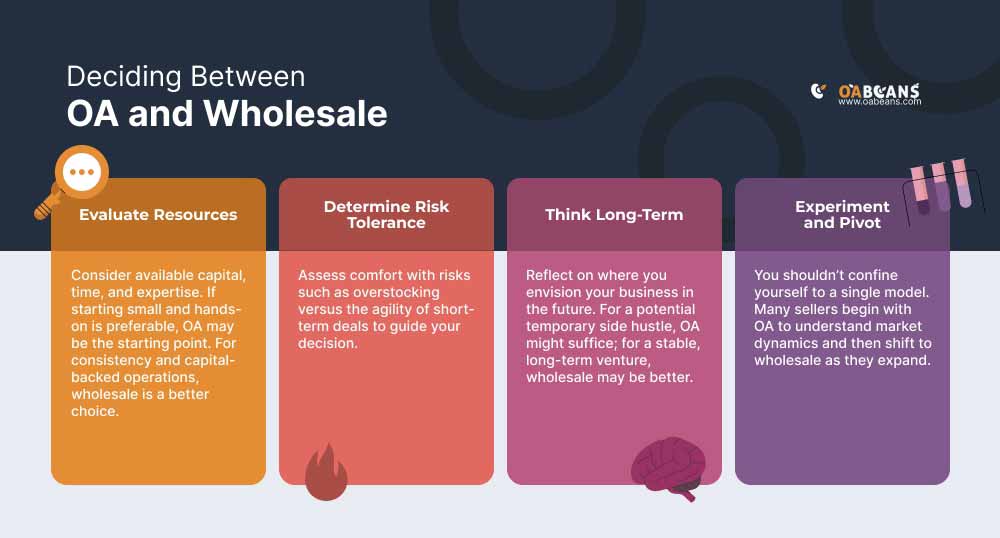
- Evaluate Resources: Consider available capital, time, and expertise. If starting small and hands-on is preferable, OA may be the starting point. For consistency and capital-backed operations, wholesale is a better choice.
- Determine Risk Tolerance: Assess comfort with risks such as overstocking versus the agility of short-term deals to guide your decision.
- Think Long-Term: Reflect on where you envision your business in the future. For a potential temporary side hustle, OA might suffice; for a stable, long-term venture, wholesale may be better.
- Experiment and Pivot: You shouldn’t confine yourself to a single model. Many sellers begin with OA to understand market dynamics and then shift to wholesale as they expand.
Final Thoughts
Ultimately, the choice between online arbitrage vs. wholesale isn’t about finding a one-size-fits-all solution; it’s about discovering the approach that aligns best with your vision. Both business models offer golden opportunities, each accompanied by its distinct set of challenges and rewards. Whether you’re an agile deal-hunter or thrive when making business relationships, the key lies in recognizing your strengths and aspirations. By considering different factors such as risk tolerance, scalability goals, time investment and initial capital, you can make the best choice for your business.


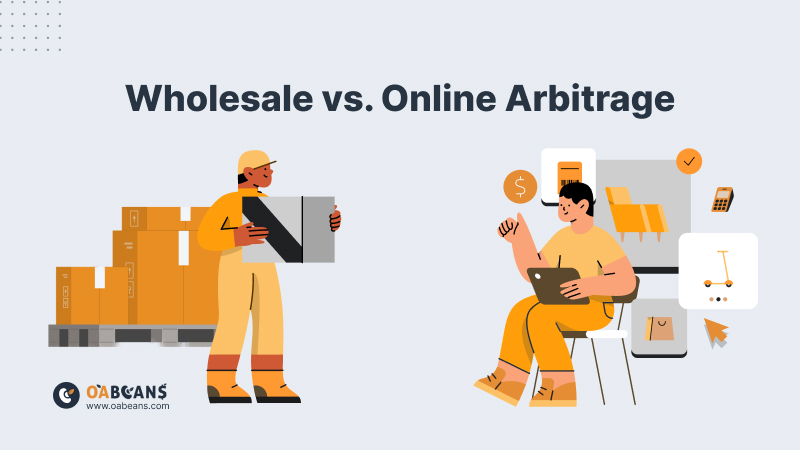
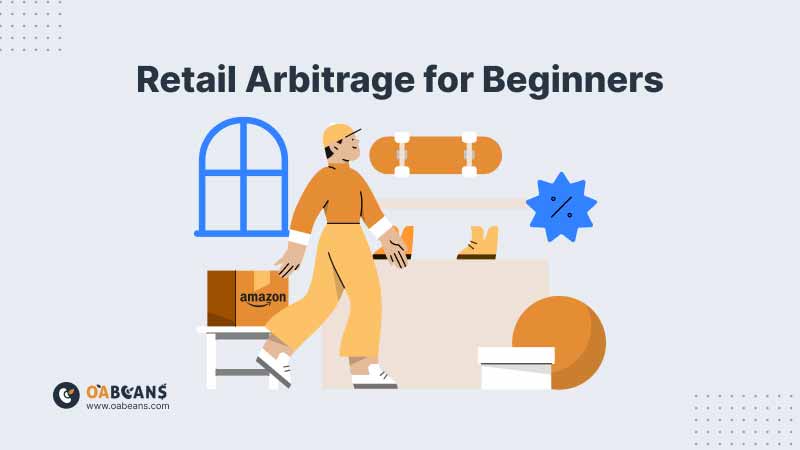
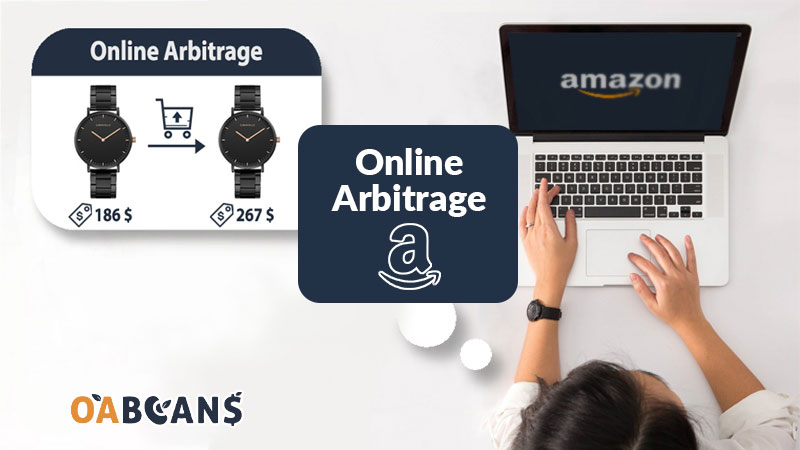
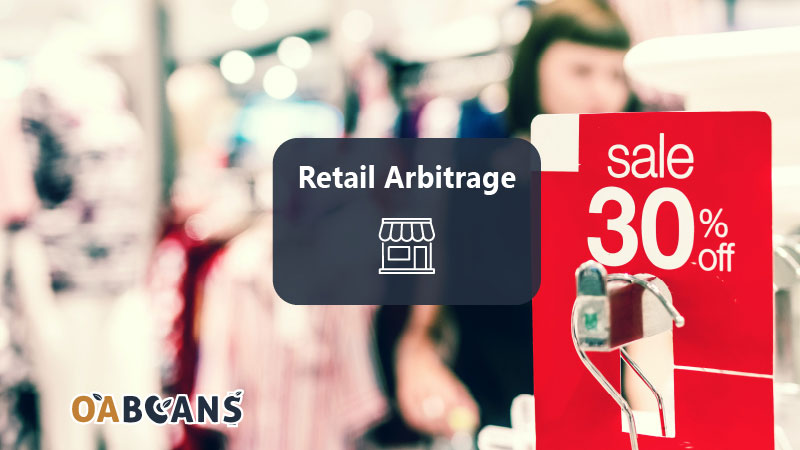
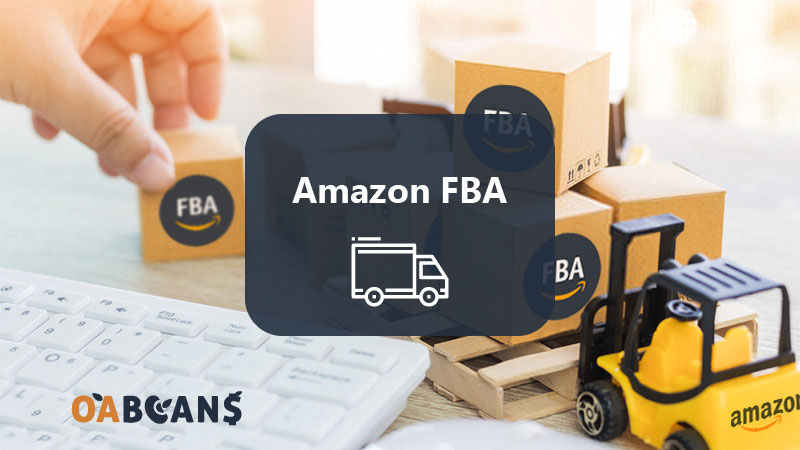



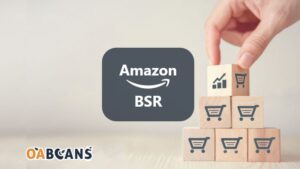
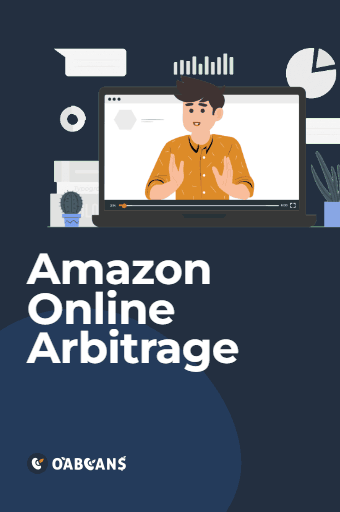

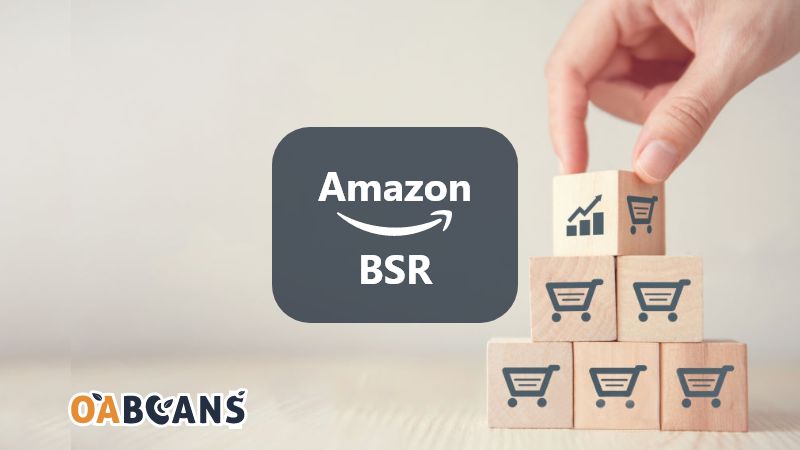
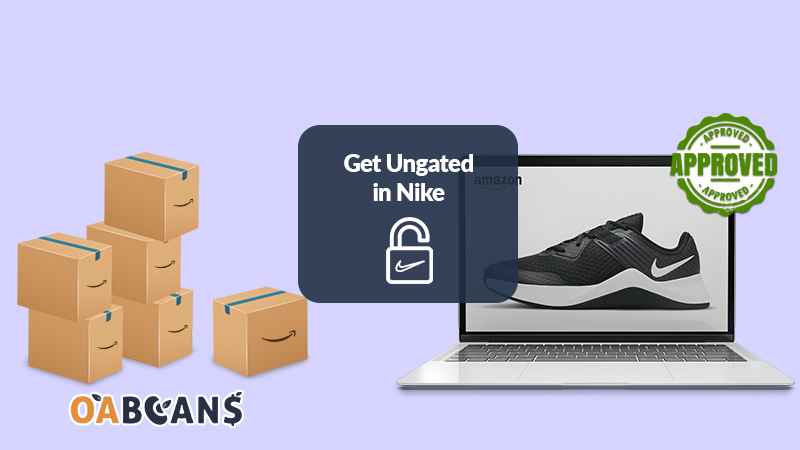
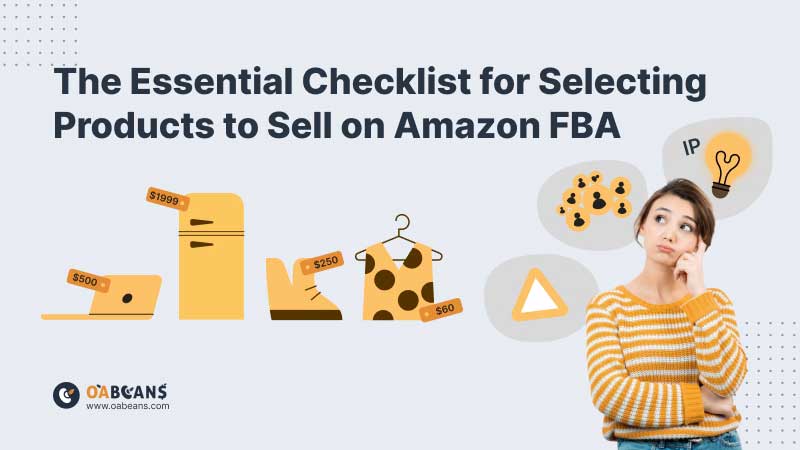






12 replies on “Online Arbitrage vs. Wholesale on Amazon”
The FBA program offers a global reach, allowing you to sell your products to customers around the world without worrying about international logistics.
Reselling on Amazon allows you to tap into the Prime membership base, making your products more attractive to millions of loyal Prime members.
Amazon’s seller tools and analytics empower you to track sales, monitor inventory, and optimize your listings for maximum visibility and profitability.
Retail arbitrage allows you to take advantage of seasonal trends, clearance sales, and promotional offers in retail stores, maximizing your profit potential during peak buying periods.
By engaging in online arbitrage on Amazon, you can enjoy the convenience of sourcing products from the comfort of your own home.
The scalability of the Amazon FBA business model allows sellers to expand their product offerings and increase sales without worrying about storage or logistics.
Reselling on Amazon allows you to establish long-term relationships with loyal customers, leading to repeat purchases and a sustainable business.
The supportive community of retail arbitrage sellers on Amazon offers valuable resources, tips, and strategies to help you succeed in this exciting business model.
Amazon’s sponsored advertising programs, such as Sponsored Products, can help boost the visibility of your listings and drive targeted traffic to your products.
With Amazon’s secure payment system and reliable customer service, you can feel confident that your transactions are protected and your customers are well taken care of.
With Amazon’s seller central dashboard, resellers can easily manage their inventory, pricing, and customer interactions.
Appreciate you sharing, great article post.Really looking forward to read more.